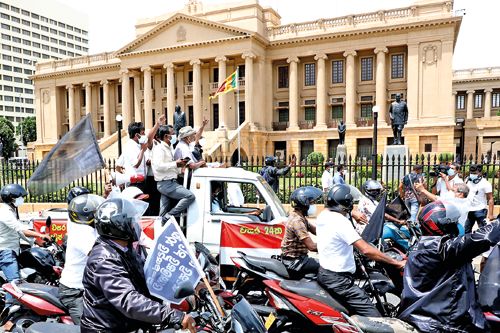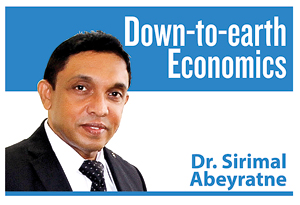Brick that fell on the head
View(s):
Protesters of the KNDU bill outside the Presidential Secretariat. Pic by M.A. Pushpa Kumara..
Last week I was invited to moderate a webinar panel discussion, organised by the Veemansa Initiative – a newly established think tank in Colombo. It was on the “Kothalawala National Defence University Bill” or the KNDU Bill. In the initial stages after being launched, Veemansa held a series of webinars on hot issues in the country such as the ‘Foreign Debt Crisis’ with the participation of the Central Bank Governor Prof. W.D. Lakshman and the ‘Colombo Port City Bill’ with the participation of the Secretary to the President Dr. P.B. Jayasundara.
The KNDU Bill is of a similar type which has already caused an uproar among some of the university academics. Their arguments are primarily centred around three types of issues attributed to the KNDU Bill – militarisation of higher education, selling education for money, and the possible quality deterioration. Well; any of these arguments do not stand strong in providing sound principles of higher education that are applied internationally.
The sacred cow
My point is anyway, a different one: The arguments presented here imply that what we have established and practiced here in Sri Lanka is the “ideal model” of higher education in the world! This “sacred cow” should not be touched by anyone. I think that without proper care and nourishment, the sacred cow is chronically ill. It needs a complete treatment rather than “bypass” operations – to use a term coined by Dr. Sujatha Gamage, one of the panelists at the webinar.
When the overall reform is politically incorrect, the strategic approaches of the governments were to push into ‘bypass operations’, leaving the “whole” to get rotten as it does and, get at least a “part” right. Even in the higher education sector, some of the ‘bypass operations’ were successful; an example of a success story is the establishment of the Sri Lanka Institute of Information Technology (SLIIT). In some cases, even the ‘bypass operations’ have not succeeded; a recent example is the failed establishment of the South Asian Institute of Technology and Medicine (SAITM).
If we diagnose the main problem of Sri Lanka’s higher education sector today, I would compress everything into one fundamental issue – lack of exposure. A major breakthrough in overcoming this higher education impasse was proposed in the government’s policy vision 2010 – Mahinda Chinthana: Policy Vision for the Future. It was to take a leap forward in transforming Sri Lanka to a “global knowledge hub” in Asia.
While referring to the ancient glory of the country as an international knowledge centre in the region, this policy document identifies its disastrous deterioration over time. The policy document also recognises the unemployment of the educated youth and the problem of brain drain. The aim of the reform process envisaged in the policy document was to create knowledge in line with the requirements of Sri Lanka as a dynamic global hub in key areas and to make the country a key hub for knowledge and learning in the world. Such a vision could have seen Sri Lanka marching forward in making the country a global centre of excellence in higher education.
Global knowledge hub
What does it require for a country to be a global hub of knowledge? The word “hub” literally means the centre of a wheel connected to its perimeter with spokes; then, an essential character of a global hub in economic terms is its connectivity with the rest of the world.
 If it is the case, then, in terms of the higher education sector, how do we recognise this connectivity which makes the country a global knowledge hub? The country should be able to export knowledge to the world and to import knowledge from the world. In order to export knowledge, the country should produce knowledge, while for the production of knowledge the country should also import knowledge as an input. It is the major requirement for a global knowledge hub.
If it is the case, then, in terms of the higher education sector, how do we recognise this connectivity which makes the country a global knowledge hub? The country should be able to export knowledge to the world and to import knowledge from the world. In order to export knowledge, the country should produce knowledge, while for the production of knowledge the country should also import knowledge as an input. It is the major requirement for a global knowledge hub.
How do we export and import knowledge in a global hub? In the most preliminary sense, there should be foreign students learning in our universities resulting in an export of knowledge and earning foreign exchange in return. Then our students would also study in a global environment competing with foreign students. On the other hand, there should be foreign professors teaching in our universities, resulting in an import of knowledge. Then our professors would also teach in a global environment competing with foreign professors.
When I said this once at a discussion forum, someone remarked: “Then your own position (as a professor) would have been challenged”. Absolutely true! If I am incompetent, I would be ousted; but I would also have the opportunity to become even more competent!
In general, a knowledge hub means a centre of creating, using and disseminating knowledge products. Therefore, a knowledge hub should be a centre for excellence for research, teaching, publications, creating new knowledge and application of knowledge to solve real world problems.
Free education for the minority
When I told my foreign friends whom I met abroad during the time of my Master’s studies in the late-1980s, that we in Sri Lanka have the privilege of “free education”, quite often they got confused.
“Education is not a free good”, they said in response, providing an economic answer.
Their confused responses implied two things to me: The first is that “free education” in the Sri Lankan context is not common in the world. The second is that the supply of education is not free; it has a cost which has to be paid by someone.
It is well-known that while over 300,000 Sri Lankan students sit the GCE Advanced Level examination every year, the government can afford to give the privilege of “free education” only to 10 percent it. And we are protesting to defend the privilege of 10 percent, leaving out 90 percent whose “freedom of education” has been blocked. Someone could argue for giving the same free education to that 90 percent too. Well; we all know that is impossible. Besides, it doesn’t solve our fundamental issue in higher education.
My batchmate, Prof. Athula Ranasinghe’s doctoral research was titled as “A Pearl of Great Price: The Free Education System in Sri Lanka”. Let me quote some controversial findings of his research. It has unveiled a strong link between the family background and the education attainment. This means that historically free education has not encouraged those students who stop education due to reasons other than its direct cost! In other words, this means that it is the children of the rich who have benefited most from the free education system!
Most of you who read this column might find this hard to subscribe to, because most of us have succeeded through free education. The point is that when one person succeeds, nine persons drop out!
The red brick
Many had called the system of free education from kindergarten to university as “a pearl of great price”. Whenever it is about free education, nobody forgets the name of the then Minister for Education Dr. C. W. W. Kannangara, who led the Special Committee which provided the recommendations for the free education system in 1943.
What is interesting however, is that this committee did not cover “higher education” to be brought under the proposed free education system. As one of the critiques of the policy has claimed “…this pearl of great price was dropped like a red brick on to the heads of the members of the Special Committee at the 88th meeting of the 90 meetings”.
Finally, my argument too is not against the ‘pearl of great price’. Rather it’s opposite; with broad-based reforms it can be made accessible to many instead of a few on the one hand and it can be made more valuable in the global context on the other hand.
(The writer is a Professor of Economics at the University of Colombo and can be reached at sirimal@econ.cmb.ac.lk and follow on Twitter @SirimalAshoka).


